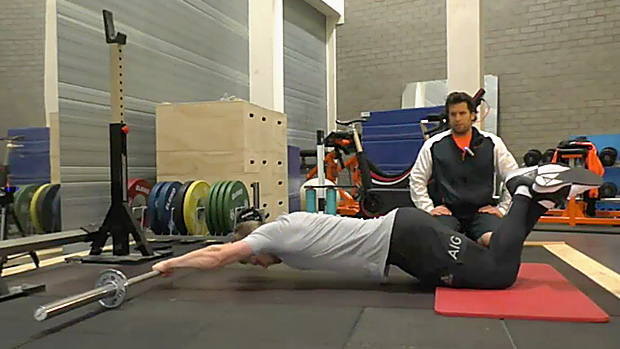In my last article, we learned what the legendary weightlifter Doug Hepburn thought about training. Now let's take a look at some of his favorite training programs and put that info into action.
Hepburn obviously wasn't concerned with marketing or advertising when he named his two most effective programs. The first plan we're going to cover is the "A Program." The second program is – yes, you guessed it – the "B Program." Don't let the titles fool you. Whatever they're lacking in inspiration, they make up for in building impressive size and strength.

Hepburn had incredible results with this training program and said it worked just as well for others. He claimed the "A Program" would add 120 pounds to any compound exercise in one year, and would add 60 pounds to any isolation exercise. Hepburn said you could see continuous progress for one year, and in many cases, two years or more.
The workouts in this plan contain two parts. First, the trainee starts with a power routine for developing maximum strength in the muscles, tendons, and ligaments. This is followed by a "pump routine" for developing maximum size and endurance.
Hepburn said you should always do the power phase first, which makes perfect sense. Heavy weights and low reps stimulate the central nervous system (CNS) and get you primed for the higher rep sets later in the workout. The opposite, however, doesn't have the same effect.
The workout is designed to first get the beneficial CNS stimulation, and then finish off with higher reps to pump some blood into the worked bodyparts, which builds muscle and facilitates recovery.
The "A Program" requires a great deal of patience and discipline. Not discipline to train in a hyper-intense manner, but discipline to restrain yourself and not train intensely. The program is well-planned, and the gradual, progressive volume ensures that overtraining is avoided.
Some of the workouts might feel unproductive, in terms of how you feel afterwards, but remember that the goal of the workout isn't to induce fatigue and soreness. The goal is to induce strength and power, which doesn't come about by running yourself into the ground. Make sure you follow the program to the letter, and avoid the natural inclination to modify things and make the program harder.
Power Phase
Choose a weight you can lift eight times and do 8 sets of 2 in the first workout. Rest two to three minutes between each set. The weight will feel light... and that's the point.
You have to practice each lift to get better, but I don't mean practicing with poor form. Execute every rep with perfect form, which shouldn't be difficult if you're using your true eight-rep max and taking adequate breaks between each set.
At the next workout, keep the weight the same, but increase the overall reps by doing 7x2 and 1x3. At the third workout, do 6x2 and 2x3. Keep adjusting, to add an additional set of three, until you get up to a full workout of 8x3. At this point, add 10 pounds for large muscle groups, and five pounds for small muscle groups, and go back to 8x2.
Pump Phase
After the power phase of the workout, take a five minute break, then do the pump phase. Reduce the training poundage by 20% and do 3x6. In the next workout, do 2x6 and 1x7. The workout after that would be 1x6 and 2x7. Continue adjusting the volume in the following workouts until you're up to 3x8. At that point, add five pounds, and start over at 3x6.
Similar to the "A Program," Hepburn claimed the "B Program" would produce progressive results for at least a year, or in some cases, two to three years. Hepburn also said that you'll never feel like you're struggling on the program.
That's a good thing for trainees interested in actual results. It's probably not what stimulus-addicted trainees want to hear, but that's just too bad... you'll have to deal with it if you want to reach your goals.
Considering how the program is laid out, you really can't reach an overtrained state, unless you do too many exercises, choose a starting weight that's too heavy, or deliberately avoid food and sleep.
The "B Program" is more of a pure strength and power program, with a focus on singles. Hepburn believed that single rep training led to the fastest strength gains. Like the "A Program," this plan also uses two styles of training in each workout.
Follow the program to the letter, and don't add any of your own modifications. Hepburn knew more about productive strength training than you do, so don't over-analyze the program.
Power Phase
After doing two warm-up sets, choose a weight you can handle for three reps, and do 5x1. Rest three to five minutes between each set. At the next workout, do 6x1. If you can't complete all six reps, you either started too heavy, or you aren't taking long enough breaks. The goal is to work up to 8x1 over several workouts.
When you reach 8x1, add five to ten pounds, drop back to 5x1, and repeat the process. This manner of progression automatically cycles the intensity to avoid overtraining. As the workout's intensity goes up, the volume decreases to induce adaptation.
Pump Phase
After the power phase of the workout, take a ten to fifteen minute break, and then do the pump routine. Take a weight you can comfortably lift for eight reps, and do 6x3, resting just one minute between each set. At the second workout, do 5x3 and 1x4. The third workout would be 4x3 and 2x4. Once you've worked up to 6x5, increase five to ten pounds, and return to 6x3.
If you find the training to be too much to handle, and you aren't making progress, Hepburn's recommendation was to cut out the power routine, and do only the pump routine of each program for two to three weeks. Alternatively, you could start the power phase with 3x1 at the first workout, to give yourself more time to work up to 8x1.
The basic schedule recommendations are the same for both the A and B programs. These workouts are an example of the "A Program."
Training Twice per Week
If you can only train two times a week, train on Monday and Thursday. Use the military press, bent-over row, and squat on Monday. On Thursday, do the bench press, weighted pull-up, and deadlift.
Monday
| Exercise | Sets | Reps | |
|---|---|---|---|
| Power Phase | |||
| A1 | Barbell Military Press | 8 | 2 |
| A2 | Barbell Bent-over Row | 8 | 2 |
| Rest 90 seconds between each set of A1 and A2. Go back and forth between the sets until all the sets are completed. Rest two minutes, and then continue. | |||
| B1 | Squat | 8 | 2 |
| B2 | Double Dumbbell or Kettlebell Swing | 8 | 2 |
| Rest 90 seconds between each set of B1 and B2. Go back and forth between the sets until all the sets are completed. Take a full five minute break, and then do the Pump Phase. | |||
| Pump Phase | |||
| A1 | Barbell Military Press | 3 | 6 |
| A2 | Barbell Bent-over Row | 3 | 6 |
| Rest one minute between each set of A1 and A2. Go back and forth between the sets until all the sets are completed. Rest two minutes, and then continue. | |||
| B1 | Squat | 3 | 6 |
| B2 | Double Dumbbell or Kettlebell Swing | 3 | 6 |
| Rest one minute between each set of B1 and B2. Go back and forth between the sets until all the sets are completed. | |||
Thursday
| Exercise | Sets | Reps | |
|---|---|---|---|
| Power Phase | |||
| A1 | Barbell Bench Press | 8 | 2 |
| A2 | Weighted Pull-up | 8 | 2 |
| Rest 90 seconds between each set of A1 and A2. Go back and forth between the sets until all the sets are completed. Rest two minutes, and then continue. | |||
| B | Deadlift | 8 | 2 |
| Take a full five minute break, and then do the pump phase. | |||
| Pump Phase | |||
| A1 | Barbell Bench Press | 3 | 6 |
| A2 | Weighted Pull-up | 3 | 6 |
| Rest one minute between each set of A1 and A2. Go back and forth between the sets until all the sets are completed. Rest two minutes, and then continue. | |||
| B | Deadlift | 3 | 6 |
| Rest 90 seconds between sets. | |||
Training Four Times per Week
If you have four days to devote to training, work each exercise twice per week.
Monday and Thursday
| Exercise | Sets | Reps | |
|---|---|---|---|
| Power Phase | |||
| A1 | Barbell Military Press | 8 | 2 |
| A2 | Barbell Bent-over Row | 8 | 2 |
| Rest 90 seconds between each set of A1 and A2. Go back and forth between the sets until all the sets are completed. Rest two minutes, and then continue. | |||
| B1 | Squat | 8 | 2 |
| B2 | Double Dumbbell One-leg Deadlift | 8 | 2 |
| Rest 90 seconds between each set of B1 and B2. Go back and forth between the sets until all the sets are completed. Take a full five minute break, and then do the Pump Phase | |||
| Pump Phase | |||
| A1 | Barbell Military Press | 3 | 6 |
| A2 | Barbell Bent-over Row | 3 | 6 |
| Rest one minute between each set of A1 and A2. Go back and forth between the sets until all the sets are completed. Rest two minutes, and then continue. | |||
| B1 | Squat | 3 | 6 |
| B2 | Double Dumbbell One-leg Deadlift | 3 | 6 |
| Rest one minute between each set of B1 and B2. Go back and forth between the sets until all the sets are completed. | |||
Tuesday and Friday
| Exercise | Sets | Reps | |
|---|---|---|---|
| Power Phase | |||
| A1 | Barbell Bench Press | 8 | 2 |
| A2 | Weighted Pull-up | 8 | 2 |
| Rest 90 seconds between each set of A1 and A2. Go back and forth between the sets until all the sets are completed. Rest two minutes, and then continue. | |||
| B | Deadlift | 8 | 2 |
| Take a full five minute break, and then do the Pump Phase. | |||
| Pump Phase | |||
| A1 | Barbell Bench Press | 3 | 6 |
| A2 | Weighted Pull-up | 3 | 6 |
| Rest one minute between each set of A1 and A2. Go back and forth between the sets until all the sets are completed. Rest two minutes, and then continue. | |||
| B | Deadlift | 3 | 6 |
| Rest 90 seconds between each set. | |||
Doug Hepburn laid out the rules for a program that will develop tremendous size, strength, and power. Follow the Hepburn plan for a few months and let me know what happens.
But don't forget one of the most important points that Hepburn made in his book: Have a life outside of training. Do the workouts and do them well, but afterwards, get your mind off training.
For more information on Doug Hepburn's life and training philosophy, check out the exceptional book Strongman: The Doug Hepburn Story by Tom Thurston.
T Nation earns from qualifying purchases as an Amazon Associate. Read more about our policy.




